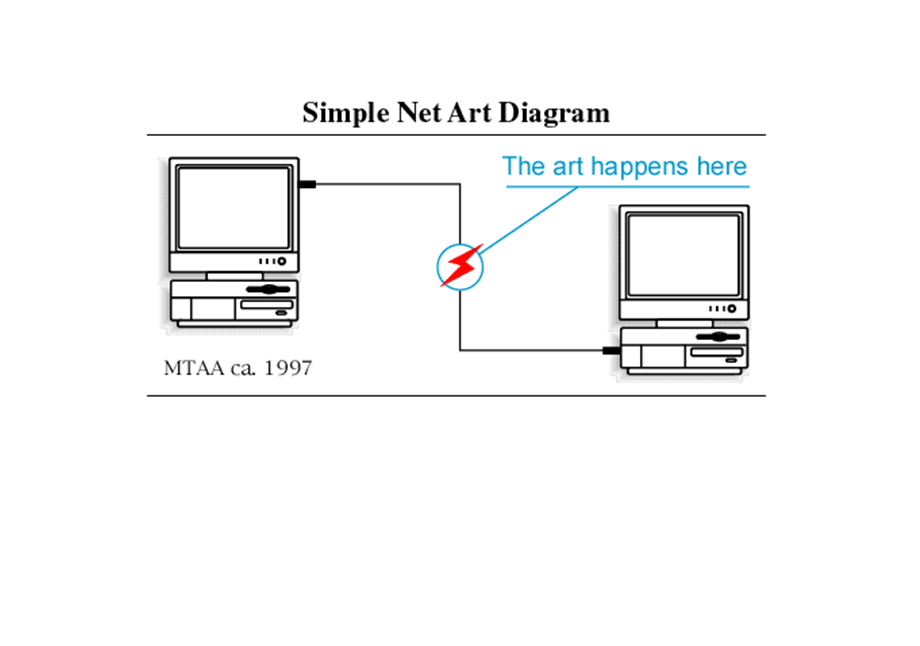- The school
- Studies and Research
- BACHELOR
- MASTER
- DOCTORATE
- RESEARCH
- TRANSDISCIPLINARITY
- POOLS
- CONTINUING EDUCATION
- Continuing education 2025-2026
- Artificial Intelligence, initiation
- Artificial Intelligence, Advanced
- Artificial intelligence open-source, ComfyUI
- Creative coding
- Engage with drawing
- Frame-by-frame animation
- 3D exhibition modeling in SketchUp
- 3D modeling, Blender
- Point cloud scanning
- Documentary podcast
- Serious games
- For students
- Studying at the HEAD
- InfoLab
- Living in Geneva
- Tuition fees and sholarship
- Library
- Regulations and instructions
- Projects
- Events
- Press
- Partnerships and prizes

Charles Peterson, "Audience" (Barcelona, 1996)
© Charles Peterson
© Charles Peterson
Viable System Model
© Stafford Beer
© Stafford Beer

Simple Net Art Diagram, ca. 1997. Animated GIF.
© MTAA
© MTAA
Doctorat - Re-decentralize design: Tools for a new spatial design practice
September 2020 to September 2024
Auteur : Juan Gomez
Début de la thèse : 09.2020
Fin de la thèse prévu : 09.2024
Co-direction: Prof. Anthony Masure (HEAD – Genève), Prof. Jeffrey Huang (EPFL)
Keywords: Decentralized technologies, P2P networks, Wireless Connectivity, Smart Cities, Algorithmic Governance, Participatory Design, Commoning practices, Research through design, Network Infrastructure, Blockchain;
Decentralized technologies is a term used to describe digital technologies which challenge the traditional centralized server model of prevailing software-hardware infrastructures. Examples of this range from Blockchain backed cryptocurrencies, which have been im- plemented successfully as alternative economic models for the current global monetary exchange(2009), to websites that could be hosted by their creators and be forked by others seamlessly (2013).
Decentralized technologies are being designed with a set of principles and values that contrast with the current political, labour, and social ones of today’s world and are poten- tially the tools for a phase of informatics described as Web 3 or Decentralized Web. At the core of these technologies is the development of protocols such as Hypercore1 (2013), IPFS2 (2015) or Scuttlebutt3 (2014) which allow for peer-to-peer file exchange that introduce unique identification via content addressing and not a location addressing compared to the HTTP protocol. Decentralised protocols challenge the current infrastructure of the internet but also it’s the power structures put in place by many of the big internet actors and governments that have so far invested in their infrastructure.
The history of informatics has been shaped by a constant flux between decentralized phases and centralizing phases, 30 years after the creation of the internet, historians identify that today there’s a discourse towards the Web 3 or Decentralized Web, that allows for exchanges of value without the need of intermediaries, this new phase of the internet could also impact some urbanism practices as seen in the plans of some actors to propose urbanistic master plans through network infrastructures with the promise of efficiency, community peer-to-peer WiFi networks for participatory urbanism and the use of blockchain and cryptocurrencies as part of the structuration of neighbourhoods. Although the concept of Space and its relation- ship to society has been analyzed by Henry Lefevbre among others, little has been explored from Web 3 mouvement, related to spatial matters such as contemporary urbanism and creative practices that shape the city. Which framework(s) of thought to analyse this set of technologies and their impact on spatial practices and society? Some researchers call it The right(s) to the hybrid city4 as a call to action.
My thesis proposal elaborates on an action-based design research, operating a practical and theoretical inquiry on the roles of decentralized technologies and Peer to Peer networks within creative practices. As some of these technologies are still being developed and in beta phases, a set of speculative design artefacts will be prototyped and exposed to use as prompts to further inquiry the impact of these technologies in spatial practices. The feed- back and reflection will be following the methodological tools from the reflective practice proposed by Donald Shön (Shön 1983) as well as many of the Designing Through Research (DTR) academics. The research aims to expand these artistic and design fields/practices from a technical perspective/standpoint producing both new knowledge and forms of social scenarios via design methods
Voir tous les projets de recherche
